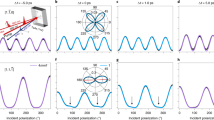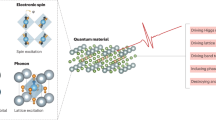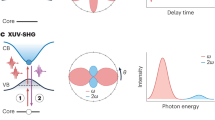Abstract
The recently developed notion of parity–time (PT) symmetry in optical systems has spawned intriguing prospects. So far, most experimental implementations have been reported in solid-state systems. Here, we report the first experimental demonstration of optical anti-PT symmetry—the counterpart of conventional PT symmetry—in a warm atomic-vapour cell. Rapid coherence transport via flying atoms leads to a dissipative coupling between two long-lived atomic spin waves, allowing for the observation of the essential features of anti-PT symmetry with unprecedented precision on the phase-transition threshold, as well as refractionless light propagation. Moreover, we show that a linear or nonlinear interaction between the two spatially separated beams can be achieved. Our results advance non-Hermitian physics by bridging to the field of atomic, molecular and optical physics, where new phenomena and applications in quantum and nonlinear optics aided by (anti-)PT symmetry could be anticipated.
This is a preview of subscription content, access via your institution
Access options
Subscribe to this journal
Receive 12 print issues and online access
$209.00 per year
only $17.42 per issue
Buy this article
- Purchase on Springer Link
- Instant access to full article PDF
Prices may be subject to local taxes which are calculated during checkout






Similar content being viewed by others
References
Bender, C. M. & Boettcher, S. Real spectra in non-Hermitian Hamiltonians having PT symmetry. Phys. Rev. Lett. 80, 5243–5246 (1998).
Bender, C. M., Boettcher, S. & Meisinger, P. N. PT-symmetric quantum mechanics. J. Math. Phys. 40, 2201–2229 (1999).
Bender, C. M. Making sense of non-Hermitian Hamiltonians. Rep. Prog. Phys. 70, 947–1018 (2007).
Mostafazadeh, A. Pseudo-Hermiticity versus PT symmetry: the necessary condition for the reality of the spectrum of a non-Hermitian Hamiltonian. J. Math. Phys. 43, 205–214 (2002).
El-Ganainy, R., Makris, K. G., Christodoulides, D. N. & Musslimani, Z. H. Theory of coupled optical PT-symmetric structures. Opt. Lett. 32, 2632–2634 (2007).
Guo, A. et al. Observation of PT-symmetry breaking in complex optical potentials. Phys. Rev. Lett. 103, 093902 (2009).
Ruter, C. E. et al. Observation of parity–time symmetry in optics. Nature Phys. 6, 192–195 (2010).
Bittner, S. et al. PT symmetry and spontaneous symmetry breaking in a microwave billiard. Phys. Rev. Lett. 108, 024101 (2012).
Regensburger, A. et al. Parity–time synthetic photonic lattices. Nature 488, 167–171 (2012).
Feng, L. et al. Experimental demonstration of a unidirectional reflectionless parity–time metamaterial at optical frequencies. Nature Mater. 12, 108–113 (2013).
Sun, Y., Li, H.-q., Li, J. & Chen, H. Experimental demonstration of a coherent perfect absorber with PT phase transition. Phys. Rev. Lett. 112, 143903 (2014).
Wimmer, M. et al. Observation of optical solitons in PT-symmetric lattices. Nature Commun. 6, 7782 (2015).
Chang, L. et al. Parity–time symmetry and variable optical isolation in active-passive-coupled microresonantors. Nature Photon. 8, 524–529 (2014).
Hodaei, H., Miri, M.-A., Heinrich, M., Christodoulides, D. N. & Khajavikhan, M. Parity–time-symmetric microring lasers. Science 346, 975–978 (2014).
Makris, K. G., El-Ganainy, R., Christodoulides, D. N. & Musslimani, Z. H. Beam dynamics in PT symmetric optical lattices. Phys. Rev. Lett. 100, 103904 (2008).
Lin, Z. et al. Unidirectional invisibility induced by PT-symmetric periodic structures. Phys. Rev. Lett. 106, 213901 (2011).
Longhi, S. Invisibility in PT-symmetric complex crystals. J. Phys. A 44, 485302 (2011).
Mostafazadeh, A. Invisibility and PT symmetry. Phys. Rev. A 87, 485302 (2011).
Longhi, S. Bloch oscillations in complex crystals with PT symmetry. Phys. Rev. Lett. 103, 123601 (2009).
Longhi, S. PT-symmetric laser absorber. Phys. Rev. A 82, 031801(R) (2010).
Chong, Y. D., Ge, L. & Stone, A. D. PT-symmetry breaking and laser-absorber modes in optical scattering systems. Phys. Rev. Lett. 106, 093902 (2011).
Nazari, F., Nazari, M. & Morawej-Farshi, M. K. A 2 × 2 spatial optical switch based on PT-symmetry. Opt. Lett. 36, 4368–4370 (2011).
Sukhorukov, A. A., Xu, Z. Y. & Kivshar, Y. S. Nonlinear suppression of time reversals in PT-symmetric optical couplers. Phys. Rev. A 82, 043818 (2010).
Miri, M., Wa, P. & Christodoulides, D. N. Large area single-mode parity–time-symmetric laser amplifiers. Opt. Lett. 37, 764–766 (2012).
Benisty, H. et al. Implementation of PT symmetric devices using plasmonics: principle and applications. Opt. Exp. 19, 18004–18019 (2011).
Bender, N. et al. Observation of asymmetric transport in structures with active nonlinearities. Phys. Rev. Lett. 110, 234101 (2013).
Fleury, R., Sounas, D. & Alu, A. An invisible acoustic sensor based on parity–time symmetry. Nature Commun. 6, 5905 (2015).
Berry, M. V. Optical lattices with PT symmetry are not transparent. J. Phys. A 41, 244007 (2008).
Lü, X.-Y., Jing, H., Ma, J.-Y. & Wu, Y. PT-symmetry breaking chaos in optomechanics. Phys. Rev. Lett. 114, 253601 (2015).
Ge, L. & Tureci, H. E. Antisymmetric PT-photonic structures with balanced positive-negative-index materials. Phys. Rev. A 88, 053810 (2013).
Wu, J.-H., Artoni, M. & La Rocca, G. C. Parity–time-antisymmetric atomic lattices without gain. Phys. Rev. A 91, 033811 (2015).
Hang, C., Huang, G. & Konotop, V. V. PT-symmetry with a system of three-level atoms. Phys. Rev. Lett. 110, 083604 (2013).
Sheng, J., Miri, M.-A., Christodoulides, D. N. & Xiao, M. PT-symmetric optical potentials in a coherent atomic medium. Phys. Rev. A 88, 041803(R) (2013).
Li, H., Dou, J. & Huang, G. PT symmetry via electromagnetically induced transparency. Opt. Express 21, 32053–32062 (2013).
Harris, S. E. Electromagnetically induced transparency. Phys. Today 50 (7), 36–42 (1997).
Fleischhauer, M., Imamoglu, A. & Marangos, J. P. Electromagnetically induced transparency: Optics in coherent media. Rev. Mod. Phys. 77, 633–673 (2005).
Wen, J., Du, S., Chen, H. & Xiao, M. Electromagnetically induced Talbot effect. Appl. Phys. Lett. 98, 081108 (2012).
Xiao, Y. et al. Slow light beam splitter. Phys. Rev. Lett. 101, 043601 (2008).
Feng, L., Li, P., Jiang, L., Wen, J. & Xiao, Y. Coherence-assisted resonance with sub-transit-limited linewidth. Phys. Rev. Lett. 109, 233006 (2012).
Ling, H., Li, Y. & Xiao, M. Electromagnetically induced grating: homogeneously broadened medium. Phys. Rev. A 57, 1338–1344 (1998).
Liertzer, M. et al. Pump-induced exceptional points in lasers. Phys. Rev. Lett. 108, 173901 (2012).
Ramezni, H., Kottos, T., Kovanis, V. & Christodoulides, D. N. Exceptional-point dynamics in photonic honeycomb lattices with PT symmetry. Phys. Rev. A 85, 013818 (2012).
Cao, H. & Wiersig, J. Dielectric microcavities: Model systems for wave chaos and non-Hermitian physics. Rev. Mod. Phys. 87, 61–111 (2015).
Rotter, I. A non-Hermitian Hamiltonian operator and the physics of open quantum systems. J. Phys. A 42, 153001 (2009).
Moiseyev, N. Non-Hermitian Quantum Mechanics (Cambridge Univ. Press, 2011).
Rotter, I. & Bird, J. P. A review of progress in the physics of open quantum systems: theory and experiment. Rep. Prog. Phys. 78, 114001 (2015).
Robinson, H. G., Ensberg, E. S. & Dehmelt, H. G. Preservation of a spin state in free atom inert surface collisions. Bull. Am. Phys. Soc. 3, 9 (1958).
Scully, M. O. & Zubairy, M. S. Quantum Optics (Cambridge Univ. Press, 1997).
Boyd, R. W. Nonlinear Optics (Academic, 2008).
Novikova, I., Walsworth, R. & Xiao, Y. Electromagnetically induced transparency-based slow and stored light in warm atoms. Laser Photon. Rev. 6, 333–353 (2012).
Xiao, Y., Novikova, I., Phillips, D. F. & Walsworth, R. L. Diffusion-induced Ramsey narrowing. Phys. Rev. Lett. 96, 043601 (2006).
Xiao, Y., Novikova, I., Phillips, D. F. & Walsworth, R. L. Repeated interaction model for diffusion-induced Ramsey narrowing. Opt. Express 16, 14128–14141 (2008).
Klein, M., Hohensee, M., Phillips, D. F. & Walsworth, R. L. Electromagnetically induced transparency in paraffin-coated vapor cells. Phys. Rev. A 83, 013826 (2011).
Xu, Z., Qu, W., Gao, R., Hu, X. & Xiao, Y. Linewidth of electromagnetically induced transparency under motional averaging in a coated vapor cell. Chinese Phys. B 22, 033202 (2013).
Budker, D. et al. Microwave transitions and nonlinear magneto-optical rotation in anti-relaxation-coated cells. Phys. Rev. A 71, 012903 (2005).
Acknowledgements
We are grateful to V. V. Albert for reading the manuscript. This work is supported by National Key Research Program of China under Grant No. 2016YFA0302000, and NNSFC under Grant No. 11322436. J.W. and L.J. acknowledge funding support from the ARO, the AFSOR MURI, the ARL CDQI program, the Alfred P. Sloan Foundation, and the David and Lucile Packard Foundation.
Author information
Authors and Affiliations
Contributions
J.W., L.J. and Y.X. conceived the idea. Y.X. supervised the project. P.P. performed the experiment. W.C., P.P. and L.J. did the theoretical derivation and numerical calculations with contributions from all other authors. J.W., L.J. and Y.X. wrote the manuscript with contributions from all other authors. All contributed to the discussion of the project and analysis of the experimental data.
Corresponding authors
Ethics declarations
Competing interests
The authors declare no competing financial interests.
Supplementary information
Supplementary information
Supplementary information (PDF 889 kb)
Rights and permissions
About this article
Cite this article
Peng, P., Cao, W., Shen, C. et al. Anti-parity–time symmetry with flying atoms. Nature Phys 12, 1139–1145 (2016). https://doi.org/10.1038/nphys3842
Received:
Accepted:
Published:
Issue Date:
DOI: https://doi.org/10.1038/nphys3842
This article is cited by
-
Diffusion metamaterials
Nature Reviews Physics (2023)
-
Theoretical and experimental characterization of non-Markovian anti-parity-time systems
Communications Physics (2023)
-
Theoretical investigation of dynamics and concurrence of entangled \({{\mathcal {P}}}{{\mathcal {T}}}\) and anti-\({{\mathcal {P}}}{{\mathcal {T}}}\) symmetric polarized photons
Scientific Reports (2023)
-
Non-Hermitian control between absorption and transparency in perfect zero-reflection magnonics
Nature Communications (2023)
-
Solitons and dynamics for the shifted reverse space–time complex modified Korteweg–de Vries equation
Nonlinear Dynamics (2023)



